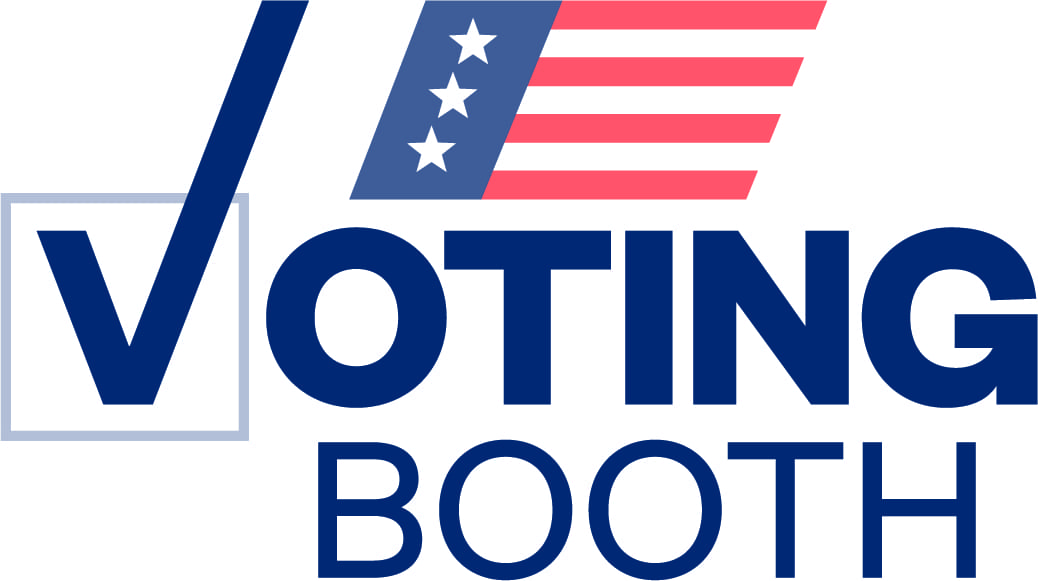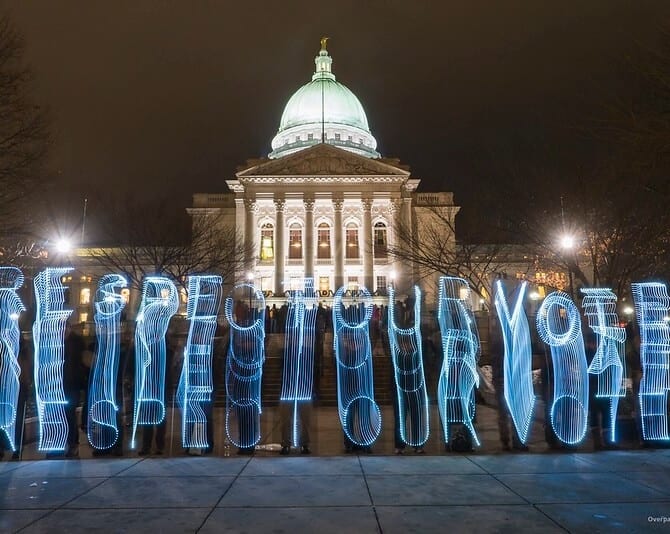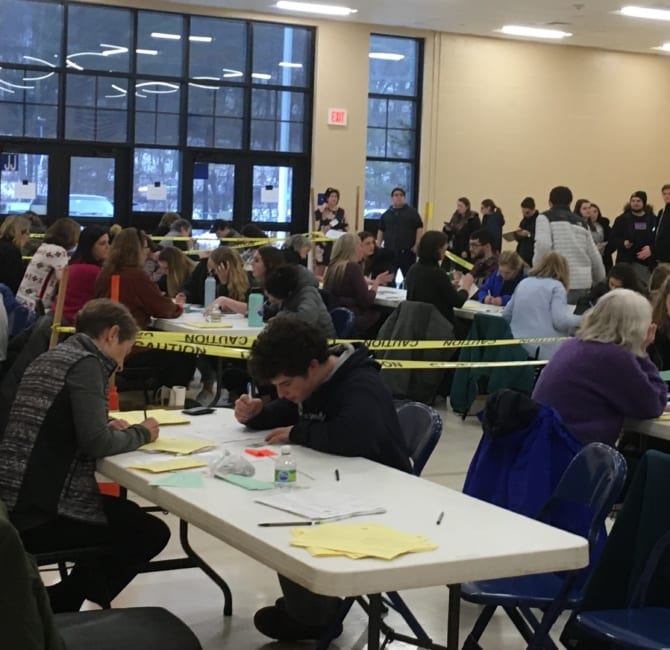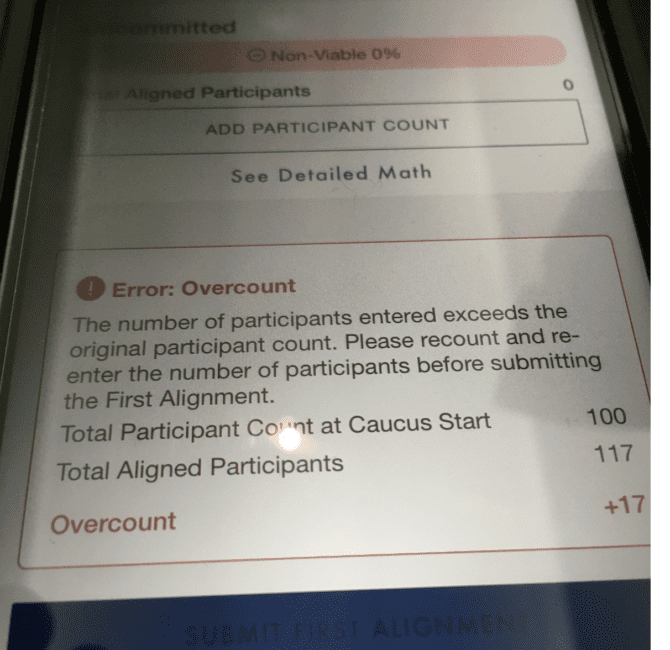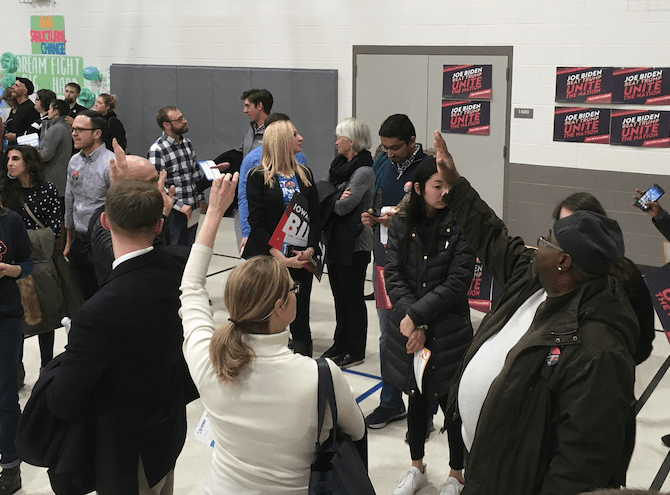Why nationwide voting by mail isn’t a silver bullet in a pandemic
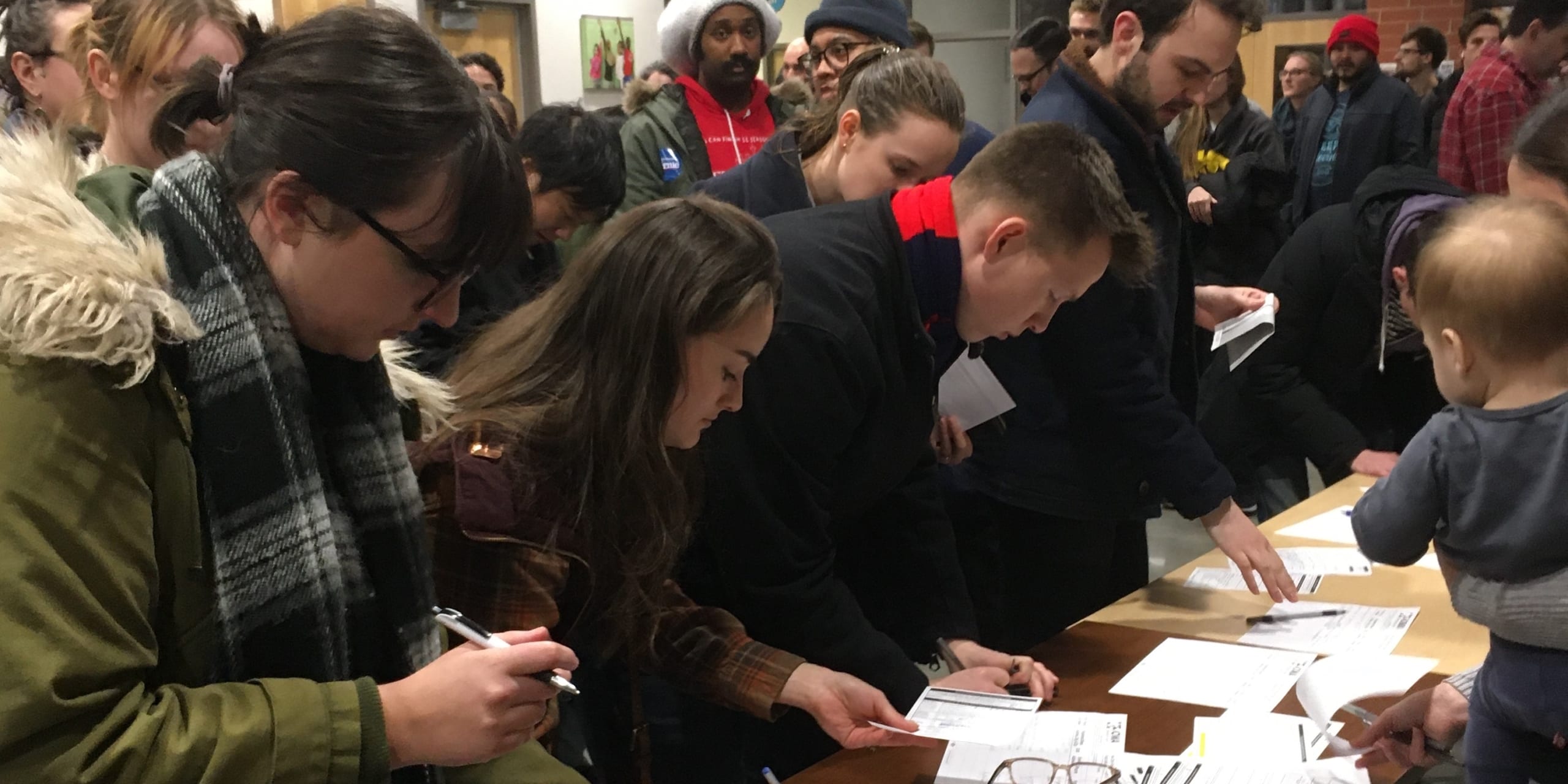
(Photo by Steven Rosenfeld)
Before the COVID-19 virus upended the 2020 election—where several states delayed presidential primaries, sparking fears that the Trump White House could seek to postpone the November election—Michigan was seeing absentee voting increase in its primary after passing election reforms via a 2018 ballot measure.
“It is a success,” said Roz Kimbrough, Detroit Department of Elections senior training specialist. “We have seven satellite offices for the Detroit municipality that we opened up to accommodate this overflow beyond just going out to the precincts and voting directly in their area—giving them availability to vote absentee.”
Kimbrough was at a command center in a cavernous downtown convention center hall where she and others were supervising 800 workers who were processing the last of 141,000 absentee ballots that had been cast in the March 10 primary. Thirty-six percent of the city of Detroit had voted absentee, compared to a 27 percent nationwide average in November 2019.Defend democracy. Click to invest in courageous progressive journalism today.
However, shifting broadly to absentee ballots—which arrive by mail and can be dropped off or mailed back—as congressional Democrats, election law scholars, party officials, campaign lawyers and activists have been saying is the best way to ensure voting next fall amid the pandemic, is not a simple task.
“Rushing to an all-mail voting system nationwide, without guaranteeing the reasonable availability of in-person polling sites as an alternative, thus risks inadvertently—but profoundly—changing the makeup of the electorate,” writes David Becker, executive director of the Center for Election Innovation & Research and former Justice Department voting section attorney, in the Washington Post.
“A switch to all-mail, or mostly mail, voting would also be a massive administrative undertaking,” he continues. “It requires planning, training, procurement of new technology and education of the electorate, particularly if in-person voting is being limited.”
There are formidable legal, technical and logistical hurdles that must be addressed if a shift to absentee and more early voting options emerges—starting with the fact that one-third of states limit absentee voting, and some even criminalize efforts to assist absentee voters. Before the pandemic broke, Florida’s Republican-controlled legislature was “advancing a bill that would prohibit people from helping with or returning any mail ballots outside their own family if they received any ‘benefit’ for doing so,” noted Marc Elias, who filed two-dozen voting rights suits on behalf of Democrats this cycle.
There are other challenges beyond the legal issues. These issues include the Postal Service’s ability to deliver ballots amid ongoing budget and workforce cuts, how the public will adapt to new voting regimens (March 17 primaries saw confusion and consternation as precincts closed and moved), and ensuring that voters are not disenfranchised because they lack mailboxes or street addresses.
Processing absentee ballots is labor-intensive and time-consuming under the best of circumstances. As the pandemic broke and public health officials advised people to avoid group activities, poll workers—typically middle-age or older—did not show up. Many election workers would still be needed to vet ballots and voters in metro areas, as the Detroit absentee ballot counting operation underscored.
“We started training back in November to get people prepared,” Kimbrough said as she and her colleagues awaited the final ballots in Michigan’s March 10 primary. Kimbrough stood like a ship captain by a riser in the center of a massive hall where nearly 800 people that she and others helped to train sat at 134 counting stations.
Under the Hood
The stations were an amalgamation of tables, forms, folders, trays, bags, and one precinct-style ballot scanner. Four to eight people staffed each station. Upstairs, in another room with 40 more workers, was where the absentee ballots first came in. The crew there did the same tasks as traditional poll workers. Instead of checking in voters at local polls, voters were vetted via their ballot envelope. The workers scanned barcodes of the voters’ precincts and validated their registrations. They compared signatures on the envelopes to images of signatures in the state drivers’ licenses file. If questions arose, those ballots were set aside for further scrutiny. Finally, the ballots were bundled and taken to the counting boards.
The process continued as carts with trays of ballots were brought into the hall. The envelopes had been previously opened, and working with 10 ballots at a time, the ballots in secrecy sleeves were put into another envelope—to keep all votes secret. Some ballots were remade if their ovals had been sloppily marked but voter intent was clear. Once distributed to the counting stations, each envelope was logged and passed before multiple sets of eyes and hands. Finally, each ballot was inserted into a scanner for counting. When the counting finished, that tabulator sent its results over a private network to a central counting room in another city election office.
“This groundwork is really laying the platform for November, for the general election,” Kimbrough said, explaining the behind-the-scenes operation involved in handling absentee ballots. “We are sequestered. We are here inside our central counting board area, and we are doing everything we can to make sure every ballot is processed.”
The city’s absentee ballot operation was largely hidden. No election worker could leave until the process was done. A handful of challengers could observe, but not go in and out until after Election Day voting had stopped. This operation, with its many steps, stages, procedures and participants, has gone on for years. It has been sequestered because officials want the workers to finish before hearing who won.
“We take our job seriously. We make sure that all the people at our tables know the rules and the laws. We follow that to the letter,” said Gloria Cartier, who has been counting absentees for 18 years and was supervising a zone. “Now, somebody is going to mess up here and there. But we are here to put them in check and make sure they correct themselves.”
Other Hurdles
Detroit’s absentee ballot counting boards offer a partial glimpse at the finish line of the vote-by-mail process. That view does not include how ballots are designed and printed (including in many languages), how voters—including new voters—would receive them, and how they are sent out and returned. The operation also does not reveal how the ballot totals are tallied and what steps verify the count.
Detroit was not using some of the newest technologies that automate parts of the process, as some big urban and suburban counties in western states have done. But its operation is reflective of states that have taken years, not months, to develop their procedures, training and workforce. The city recently updated its voting machines, like many cities in America—including equipment that could be sidelined this fall.
Within 24 hours of Michigan’s March 10 primary, pandemic-related fears broke like a tidal wave across the country and prompted reactions from local and state governments. A half-dozen states and territories have postponed their presidential primaries until June. The most abrupt turnaround was in Ohio, where the governor ignored a court order hours before the March 17 primary.
As this upheaval unfolded, policy experts began to call for a shift to absentee voting for the November election. Constitutional law experts worried that the White House might exploit the pandemic to delay the 2020 election or urge 28 states where the GOP holds a legislative majority and governor’s seat to subvert the Electoral College. These states theoretically could ignore voters and appoint enough electors to re-elect Trump.
In Congress, Sens. Amy Klobuchar, D-MN, and Ron Wyden, D-OR, proposed legislation to “allow every American the ability to vote by mail” and “expand early voting.” Advocates such as the Brennan Center released their prescriptions, which centered on expanding absentee and early voting options, wider online registration and public education. Another push came from Vote at Home, an advocacy group run by ex-election directors from western cities and states who have spent years fine-tuning vote-by-mail systems.
Materials from the group and its partners, including videos showing details of the tools and technologies seen as best practices, are a world apart from Detroit. These complex and technologically advanced systems seek to automate what previously has been done manually—such as verifying ballot envelope signatures and sorting those envelopes by precinct. Some of the elements described, such as new software that tracks each mail-in ballot, so voters can know where their ballot is, can take four-to-eight weeks to set up, one webinar said. One of the most advanced setups in Orange County, California, is a ballot printing and processing facility akin to a pressroom for newspapers.
Western states like Oregon, Washington and Colorado have spent years perfecting voting by mail. Oregon’s procedures manual is not light reading. Just how these advances can be applied to counties and states east of the Rocky Mountains in 2020 is an open question. Most promises of a silver bullet that will solve the complexities of voting have not lived up to their billing, especially when time is short. Consider that almost every new voting system that debuted in 2020’s presidential contests before the pandemic has had problems.
Detroit’s absentee ballot counting boards show that a populous county’s process involves formidable logistics, staffing and training. The videos and briefings from Vote at Home show that new technology could involve different learning curves and possibly steep costs. It also raises questions about what is not being shown, such as discussing if lower-tech steps could be undertaken to decentralize these operations.
“You don’t need machines” to verify signatures on ballot envelopes, said Jan BenDor, statewide coordinator of the Michigan Election Reform Alliance and an ex-local election director for two decades. “People do this much better than machines. You are trained to look for five or six things. It’s a gestalt perception.”
Outdated State Laws
The hurdles facing a wide pivot to absentee voting begin with updating state laws that are not supportive of voting by mail, especially in 2020 swing states. Before the pandemic, a third of the states—typically red-run—required voters to satisfy a requirement to get an absentee ballot. Michigan only passed its “no-excuse” law in 2018 by statewide initiative, which bypassed its gerrymandered GOP legislature. Kansas, for example, has been sued because it will not implement 2019 legislation that “cures,” or resolves, rejected signatures on envelopes in 2020.
Two-thirds of the states have no-excuse absentee ballots, but that doesn’t mean that their process is entirely voter-friendly. There is a wide variation when states must receive the returned ballot to be counted. Some states require ballots to be received by Election Day, while others extend that period until the week’s end. That earlier deadline means ballots that have been postmarked on Election Day, but then were held up in the mail, would not be counted.
There also are variations with state timelines for contacting voters to cure signature issues before disqualifying those ballots. And there are varying post-Election Day timelines surrounding when all of the votes have to be counted, recounted and results certified. Cumbersome balloting would conflict with some deadlines.
“It will not be enough for states to simply allow more citizens to vote by mail,” Marc Elias wrote in a March 16 commentary in the Washington Post, citing these and other concerns that he said must “now” be addressed by Congress or by state legislatures. “Otherwise, it will be again left to the courts to protect the rights of voters. We must all make sure that the barriers to voting by antiquated voting laws are not raised higher by the coronavirus.”
The logistical, technical and legal challenges surrounding a shift to absentee ballots before November’s elections are daunting—but they are not the full picture. Some in the GOP will likely weigh whether voting by mail will help or hurt their party’s prospects, just as any new voting regime could have unintended and even chaotic consequences.
Also Available on: www.rawstory.com

